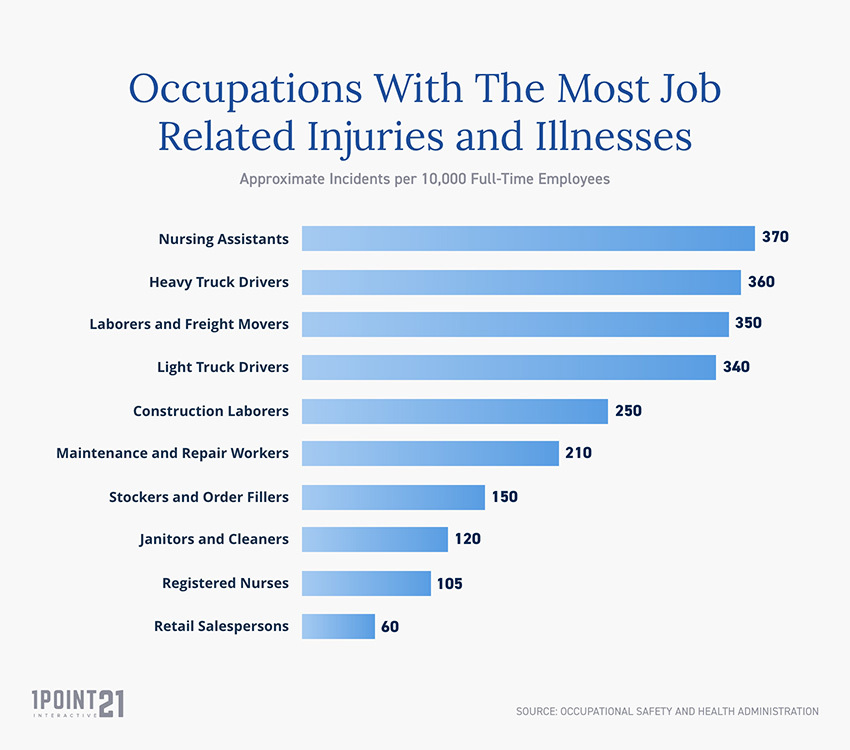This post originally appeared on: https://www.ramseylawpc.com/news/workplace-injury-statistics/.
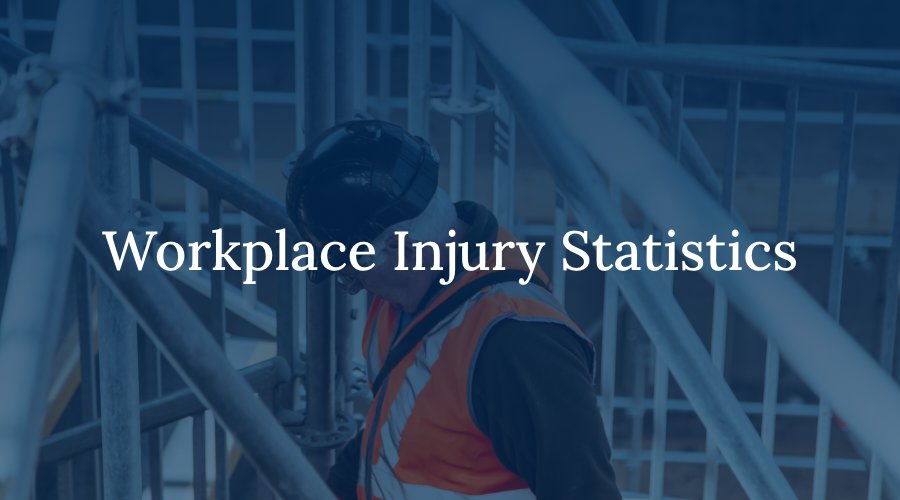
Table of Contents:
United States Population Overview
- White: 76.5%
- Hispanic or Latinx: 18.3%
- Black or African American: 13.4%
- Asian: 5.9%
- American Indian or Alaska Native: 1.3%
- Native Hawaiian or Other Pacific Islander: 0.2%
- Two or more races: 2.7%
Additionally, here are a few more statistics that may be helpful to reference as you read the statistics throughout this article:
- Women make up 50.8% of the U.S. population.
- 58.2% of the civil labor force is made up of women aged 16+.
- 87.3% of people have graduated from high school.
- 30.9% of people have at least a bachelor’s degree.
- 8.7% of people under the age 65 are a person with a disability.
- People between the ages of 18 and 65 (working age) make up 38.4% of the population.
Workplace Fatality Statistics
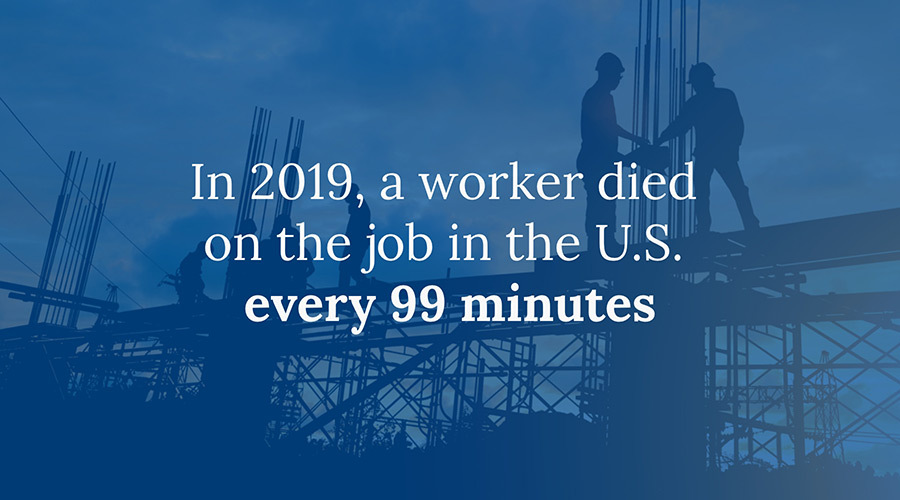
- The 5,333 fatal occupational injuries in 2019 represent the largest annual number since 2007.
- A worker died every 99 minutes from a work-related injury in 2019.
- Fatalities among workers age 55 and over increased 8 percent from 1,863 in 2018 to 2,005 in 2019, which is the largest number ever recorded for this age group.
- Hispanic or Latino worker fatalities were up 13 percent to 1,088 in 2019–a series high since 1992.
- Workplace deaths due to suicides (307) and unintentional overdoses (313) increased slightly in 2019.
- Fatalities in the private construction industry increased 5 percent to 1,061–the largest total since 2007.
- Driver/sales workers and truck drivers incurred 1,005 fatal occupational injuries, the highest since this series began in 2003.
- Transportation incidents increased 2 percent in 2019 to 2,122 cases, the most cases since this series began in 2011. Events involving transportation incidents continued to account for the largest share of fatalities.
- Falls, slips, and trips increased 11 percent in 2019 to 880.
- Exposure to harmful substances or environments led to the deaths of 642 workers in 2019, the highest figure since the series began in 2011.
- Unintentional overdoses due to nonmedical use of drugs or alcohol increased for the seventh consecutive year to 313 in 2019.
- Fatalities due to fires and explosions decreased 14 percent to 99 in 2019.
Workplace Injury & Illness Statistics (Non-Fatal)
According to the BLS’s Employer-Related Workplace Injuries and Illnesses News Release, which it published on November 4, 2020, the total number of injuries per 100 full-time workers remained unchanged from 2018 at 2.8
- There were 888,220 nonfatal injuries and illnesses that caused a private industry worker to miss at least one day of work in 2019, essentially unchanged from 2018.
- Manufacturing accounted for 15.0 percent of all private industry nonfatal injuries and illnesses in 2019
- Injuries and illnesses to manufacturing workers resulted in 32,470 DAFW cases of sprains, strains, or tears (28.0 percent); 16,790 cases of soreness or pain (14.5 percent) and 15,380 cases involving cuts, lacerations, or punctures (13.3 percent).
- Ten occupations accounted for 33.2 percent of all private industry cases involving days away from work in 2019
- laborers and freight, stock, and material movers, hand had the highest number of DAFW cases with 64,160; followed by heavy and tractor-trailer truck drivers with 47,990.
Occupations With The Most Job Related Injuries and Illnesses
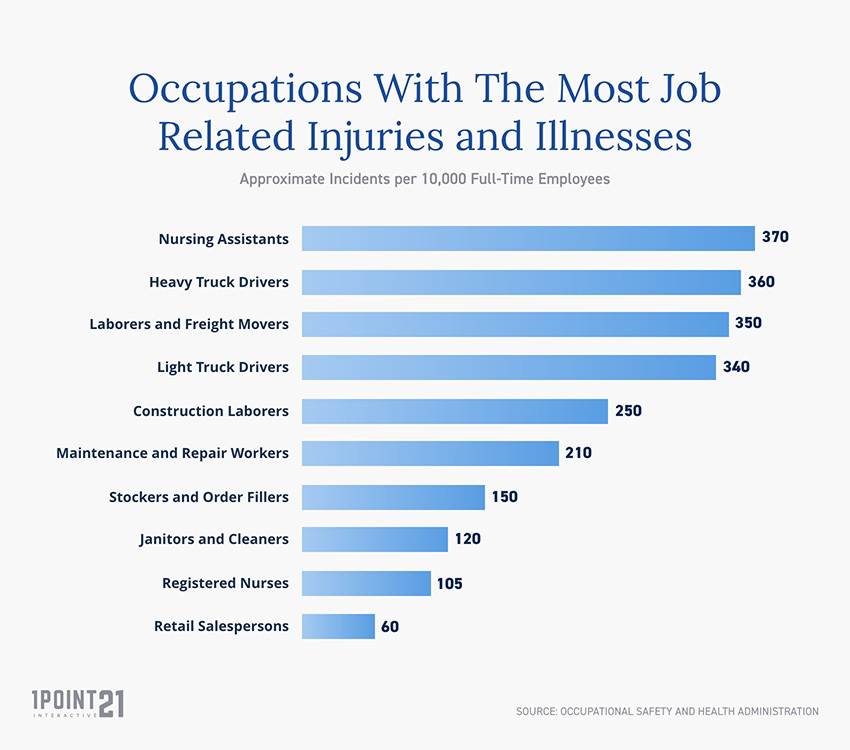
- Nursing assistants (approximately 370 incidents per 10,000 FTE)
- Heavy truck and tractor-trailer truck drivers (approximately 360 incidents per 10,000 FTE)
- Laborers and freight, stock, and material movers (approximately 350 incidents per 10,000 FTE)
- Light truck drivers (approximately 340 incidents per 10,000 FTE)
- Construction laborers (approximately 250 incidents per 10,000 FTE)
- Maintenance and repair workers (approximately 210 incidents per 10,000 FTE)
- Stockers and order fillers (approximately 150 incidents per 10,000 FTE)
- Janitors and cleaners (approximately 120 incidents per 10,000 FTE)
- Registered nurses (approximately 105 incidents per 10,000 FTE)
- Retail salespersons (approximately 60 incidents per 10,000 FTE)
*FTE stands for Full-Time Employees.
Reported Hospital Injuries By State (2015-2020)

| TEXAS |
8080 |
| FLORIDA |
5468 |
| PENNSYLVANIA |
3719 |
| OHIO |
3215 |
| ILLINOIS |
2824 |
| NEW YORK |
2521 |
| GEORGIA |
2442 |
| WISCONSIN |
1711 |
| COLORADO |
1638 |
| ALABAMA |
1540 |
| MISSOURI |
1408 |
| NEW JERSEY |
1319 |
| LOUISIANA |
1248 |
| MASSACHUSETTS |
1127 |
| OKLAHOMA |
941 |
| KANSAS |
945 |
| ARKANSAS |
931 |
| MISSISSIPPI |
920 |
| NEBRASKA |
760 |
| CONNECTICUT |
524 |
| WEST VIRGINIA |
455 |
| IDAHO |
447 |
| NORTH DAKOTA |
435 |
| SOUTH DAKOTA |
350 |
| MAINE |
301 |
| CALIFORNIA * |
284 |
| NEW HAMPSHIRE |
269 |
| MONTANA |
252 |
| DELAWARE |
208 |
| RHODE ISLAND |
175 |
| DISTRICT OF COLUMBIA |
169 |
| VIRGINIA |
164 |
| ARIZONA |
76 |
| NORTH CAROLINA |
74 |
| WASHINGTON |
72 |
| MARYLAND |
71 |
| TENNESSEE |
60 |
| OREGON |
52 |
| NEW MEXICO |
51 |
| SOUTH CAROLINA |
46 |
| HAWAII |
43 |
| KENTUCKY |
42 |
| MINNESOTA |
35 |
| MICHIGAN |
34 |
| UTAH |
31 |
| ALASKA |
23 |
| NEVADA |
21 |
| INDIANA |
20 |
| IOWA |
18 |
| WYOMING |
15 |
| VERMONT |
3 |
*California Data May Be Underreported
Additional OSHA Statistics
- Fractures, Amputations, and Cuts or Lacerations were the top 3 reported work-related injuries
- 2018 had the largest amount of reported Injuries, followed by 2019
Top 10 Injuries Reported By Type
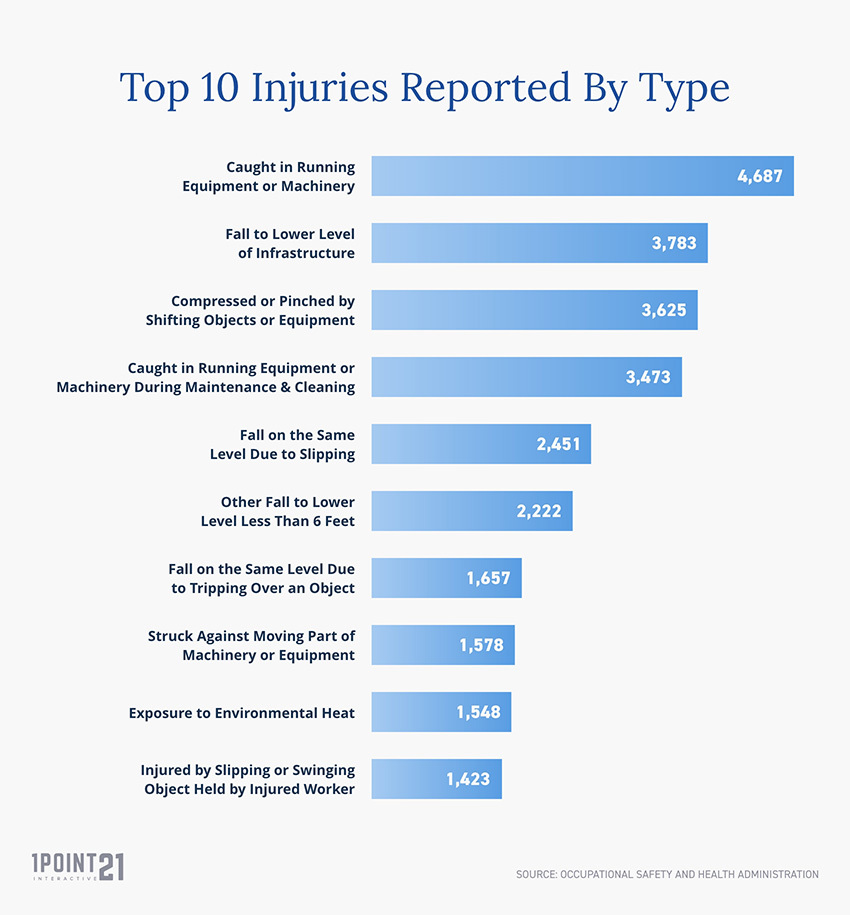
| Caught in Running Equipment or Machinery |
4687 |
| Fall to Lower Level of Infrastructure |
3783 |
| Compressed or Pinched by Shifting Objects or Equipment |
3625 |
| Caught in Running Equipment or Machinery During Maintenance & Cleaning |
3473 |
| Fall on the Same Level Due to Slipping |
2451 |
| Other Fall to Lower Level Less Than 6 Feet |
2222 |
| Fall on the Same Level Due to Tripping Over an Object |
1657 |
| Struck Against Moving Part of Machinery or Equipment |
1578 |
| Exposure to Environmental Heat |
1548 |
| Injured by Slipping or Swinging Object Held by Injured Worker |
1423 |
Top Reported Hospitalizations By Employer
| U.S. Postal Service |
889 |
| Walmart |
402 |
| UPS |
383 |
| Tyson Foods, Inc. |
218 |
| Walt Disney Parks and Resorts U.S., Inc. |
149 |
| Publix Super Markets, Inc. |
145 |
| Lowe’s Home Centers, LLC |
108 |
| Menard, Inc. |
82 |
| American Airlines |
78 |
| DHL Supply Chain |
64 |
Top 10 Most Cited OSHA Standards Violated in 2020
- Fall Protection, construction
- Hazard Communication Standard, general industry
- Respiratory Protection, general industry
- Scaffolding, general requirements, construction
- Ladders, construction
- Control of Hazardous Energy (lockout/tagout), general industry
- Powered Industrial Trucks, general industry
- Fall Protection–Training Requirements
- Eye and Face Protection
- Machinery and Machine Guarding, general requirements
Covid-19: Impact on Unemployment Rates
- In 2020, 9.8% of families include an unemployed person, double the share in the prior year
- In 2020, 9.8 percent of families included an unemployed person, twice as high as in 2019 (4.9 percent). This increase among families reflects the effect of the coronavirus pandemic on the labor market. Of the nation’s 83.1 million families, 78.2 percent had at least one employed member in 2020.
- At least one parent was employed in 88.5 percent of families with children, down from 91.4 percent in the previous year.
- In 2020, mothers of older children remained more likely to participate in the labor force than mothers with younger children. The participation rate for mothers with children under age 6, at 65.8 percent, was lower than that of mothers whose youngest child was age 6 to 17, at 75.4 percent.
- In 2020, the unemployment rate for mothers increased by 4.0 percentage points from the prior year to 7.5 percent, and the rate for fathers increased by 3.4 percentage points to 5.6 percent.
- Employed fathers remained more likely to work full time in 2020 than employed mothers; 95.6 percent of employed fathers worked full time, compared with 79.7 percent of employed mothers.
Sources:
- https://www.bls.gov/news.release/archives/cfoi_12162020.pdf
- https://www.bls.gov/news.release/famee.nr0.htm
- https://www.bls.gov/news.release/archives/osh_11042020.pdf
- https://www.osha.gov/
- https://www.osha.gov/data/commonstats
- https://www.bls.gov/news.release/famee.nr0.htm





